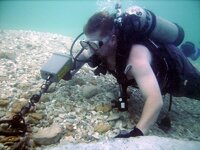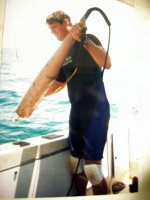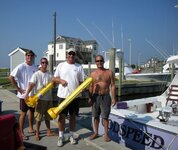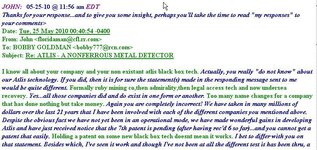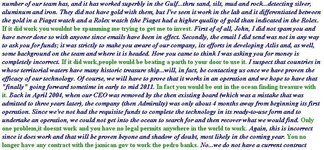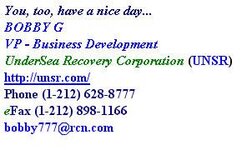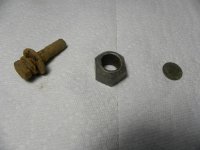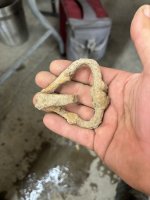Reefdrifter
Jr. Member
Hi guys............I received this e-mail last week. Anyone heard of these guys? I have not decided how it smells.....or actually what he wants. Interesting though!!!
Hi Metal Detector Aficionado: 05-28-10 @ 10:17 pm EDT
Several days ago Thunting.com sent me an email about their message board and suggested viewing their Website. Not familiar with this group, I was surprised so many people had an interest in metal detection...the reason Thunting.com got in touch with me. As the VP of Business Development for UnderSea Recovery Corporation, they apparently learned our company had recently been granted a 6th patent for its ATLIS, nonferrous metal detector. This technology is the only one of its kind in existence and "literally" has the ability to differentiate between iron-based and nonferrous-based metals (particularly gold, silver and platinum); this ability works in saltwater and detects these metals through sand, mud, coral, rock, wood and most of the usual items found in and on the ocean floor.
Your particular email address was listed in the Cc column on Thunting's email to me, but unfortunately, it did not show your name. However, I decided to send you the following information on our company...figuring it would be something you'd want to read.
I created the following message, same which will prove quite interesting if you take the time to read it. This is all very real stuff and our company, UnderSea Recovery (UNSR), should be ready to move into operations mode by early in 2011. We are currently a tiny public pinksheet company that is virtually unknown in the public media, but we expect a number of dramatic changes to take place in the coming months and especially sometime in 2011 when we start operations (hopefully) in the Pedro Bank of Jamaican territorial waters.
Attached is one pdf document giving a six-page overview on us.
We are involved in two public companies with three names and the following will help to clear up any confusion:
Admiralty Holding Company (ADMH) - This company, formed in the late 1980s was originally purchased as a shell. Management lost control during April 2004, only to regain it on 05-30-07. It is a public ( pinksheets) company and its CEO is Herbert Leeming. Management of our other company, LGAL, created a licensing agreement with ADMH during 2009 and because of doing so, ADMH will stay in limbo for the next number of months...the result of its owing $5 million to a hedge fund known as NIR Group...located in Roslyn, NY. When taking it over at the end of May 2007, a major portion of that company's debt came along with it and much of any additional monies we rec'd from NIR were used to repay many outstanding payments of ADMH. NIR is now being heavily scrutinized by both the SEC and the office of the NY State Attorney General for illicit operations.
Legal Access Technology (LGAL ) - This is another public company purchased as a shell about six years ago. Its name was not changed until recently though it still trades using the LGAL symbol. Its Website is www.unsr.com and it stands for UnderSea Recovery Corporation (UNSR). The name change was officially approved on 07-29-09 though we are still waiting for FINRA (the Financial Industry Regulatory Authority) to overcome its sluggish performance and finally approve our symbol change. We are hoping and expect that change to take place within the coming weeks. At that time LGAL will no longer exist and the symbol will officially become UNSR. In any event, LGAL reverted to the pinksheets during the summer of 2007. When the audit is completed, the company will become a "reporting" entity. Eventually we will return to the Bulletin Board and from there we just might move over to NASDAQ. As is the case with ADMH, Herbert Leeming is also CEO of this company.
UnderSea Recovery Corporation (UNSR ) - This is the name of a non-public entity we formed about six years ago. As stated above for LGAL, this company's Website is (http://unsr.com/). Take a peek at it when you have the opportunity. Unfortunately, we have not updated this site in almost five years and I suspect that it will be redone before this coming Fall. Management shown in UNSR's Website is the same as the one that has been working on all aspects of ADMH. A few individuals whom we've been working with for many years (all who have considerable backgrounds in this field) are now part of our entire management team. We've assembled what we believe is one of the most impressive operational teams in this industry and our group covers virtually every aspect necessary to carry out its intended business model(s).
The main focus of UNSR is a technology known as ATLIS, currently owned by ADMH...which we also control 100%. We have complete operational control of this technology because of a licensing agreement (and our management also controls both companies that were party to this agreement). ADMH licensed this technology to LGAL earlier this year so UNSR now has complete and exclusive control of it. Here are some thoughts on how this technology works (it is the only technology that literally has the ability to "find" and differentiate between all metals and specifically, nonferrous metals, which are those that are precious):
Assume you are placed on a 1 square mile section of the desert and told that several valuable gold and silver coins and many more pieces of iron were scattered throughout it and you've been asked to find the coins. The sand in this one square mile section is only six inches deep and is not packed down (it's loose like that on most beaches). With that information, you now consider suitable methods by which you can search for the coins. As such, you purchase a hand-held metal detector and a rake made special for scouring thru sand. You then devise a plan to search this section of the desert.
The search method you develop is called a grid…and the plan is to walk in a straight line, moving the detector to your left and then to your right, covering only six feet (in other words, three feet on each side of a straight line that runs directly in front of you as you walk). As you move in a forward direction, if you detect the presence of any iron objects (which is what the detector can find), you proceed to rake down into the sand hoping a gold or silver coin will be in close proximity of the iron piece or pieces you detected. After walking in this straight line for a couple of hours you realize this will be a very slow process. Keep in mind, hand-held metal detectors, though they can sense gold, iron and/or iron, cannot differentiate one from the other...the reason you have to use the rake to see if any gold and silver are lying in the vicinity of the metal(s) you have detected.
Another thing to understand about our ATLIS equipment when searching for nonferrous metals in the oceans; it is the only technology that both detects and “differentiates” between all ferrous (iron-based) and those of gold, silver and platinum. Additionally, it will distinguish between 18 karat and 24 karat gold.
OK...getting back to the beach situation: the grid you created in this one square mile of sand is equal-sided and extends 5,280 feet in each direction. Anyway, on this basis, searching and raking when you think there might be gold or silver nearby, you'll probably cover no more than about 20 feet each minute. At this speed and searching rate of three feet on your left and right, you will cover the first linear mile in roughly four and half hours...assuming you didn't stop to rake up a lot of sand, thinking you may have found a coin or coins.
After searching along the first linear mile of the grid, you turn around and consider starting back, covering the next six feet; however, it is evident that on your way back, you need to overlap (about) six inches of the area already searched...just in case you may have missed any coins in your sweep down the first line. Doing this, you are effectively covering "only" five feet six inches as you move in straight lines within the grid you have created. On this basis, you will need to make 960 “up and down” passes to cover the entire one square mile of this section of sand. This means it will take a total of 4,224 hours to effectively search "only" one square mile. On this basis, working a 10-hour, 6-day week, it will take 422 days, or 70 weeks (one and a third years) to search the entire one square mile of sand. And, when comparing this to being under water with scuba gear and limited air supplies, not to mention that in addition, the sand would be mixed with all sorts of debris, you begin to get an idea of the extremely difficult process involved in searching for precious metals lost in the world's oceans.
The bottom line of this completely hypothetical scenario is this: detecting iron-bearing metals in an attempt to find gold or silver that may have been scattered along with it when lost, is totally inefficient, time-consuming and extremely costly...primarily because most so-called hits of iron-based metals are probably not located within the immediate area of gold or silver (if, in fact, there are any of these precious metals to begin with).
One primary reason we developed the ATLIS technology was to approach the search and site-assessment phases in a highly systematic and professional manner. Typically...salvors using magnetometers (also called mags) are plagued with a very large quantity of false positive targets, most requiring the search ship floating on top of the water to be moored (secured to the ocean floor) and divers deployed, hoping gold and/or silver will be found in close proximity to any iron that was detected by mags (remember...mags can only detect iron-based objects to the total exclusion of nonferrous objects such as gold and/or silver). Over the course of many months and years, such false positives will probably yield little or nothing more than rusted iron cannon of yore. And over these long periods of time, repeated failures in an attempt to find any treasure quickly depletes even the wealthiest of salvors…as is almost always the case.
The foregoing discussion illustrates the rationale behind development of ATLIS and the commercial need for detection of nonferrous materials such as gold and silver. When searching specific geographic areas for historic shipwrecks, we methodically follow a prescribed grid and initially utilize conventional towed technologies such as mags, side-scan sonar and sub-bottom profiling apparatus. Grids using these instruments often cover areas of one square mile or larger. Following use of these conventional instruments, ATLIS is then deployed to precisely determine the locations of precious metals. Grids utilizing ATLIS will initially cover much smaller areas, called sections, with each section covering no more than, say, one or two thousand square feet of sea floor. As each section is completed, Atlis is moved to an adjoining or new section (with some overlap). These smaller sections will be the case "only" with the 1st generation model which is diver-manipulated. Newer (2nd and 3rd) generation models, already in the design stage, will be towed behind boats covering much larger sections/areas than those using 1st generation models. Advanced towed models (behind our boat) will move at up to seven (7) knots, which means they'll cover more sea floor area in a lot less time.
With this type of remote-sensing data, we can better design and apply archaeologically and environmentally sound methods for recovery of precious metals and other valuable materials within historic shipwreck sites. It is also important to point out that...even when gold and silver is identified, if quantities are shown to be insignificant and not commensurate with the projected cost of recovery (which can easily be figured), we have the option of moving to targets where the amount of precious metals will warrant recovery operations. This ability of ATLIS to precisely detect the location of these metals is what makes our technology so unique and highly valuable for both the company and its shareholders.
There are an estimated 9,000+ so-called treasure shipwrecks scattered around the world, with a large quantity located in the Caribbean. It is thought that more than 90 percent of these ships went down in what is considered to be shallow water (30 to 100 feet of depth) that is within sight of land. This was due to the ships breaking up on reefs and rocks.
UNSR's funding of $1.5 million is expected to fund on June 4th and it gives us the ability to finish much of the work needed to complete the ATLIS technology and make it ready for ocean operations, something we've never had the financial ability to do.
Within the next couple of months, we expect to once again start discussions with the Jamaican government to renew our expired permit with that island country...so operations can start in their territorial waters known as the Pedro Bank, a 2,000 square mile area located about 70 miles southwest of Kingston. This area is well-known for having many historic treasure ships that went down during the 1500s and 1600s when gold and silver mining was a big business in South America.
Enjoy the coming week.
BOBBY GOLDMAN
VP - Business Development
UnderSea Recovery Corporation (UNSR)
http://unsr.com/
Phone (1-212) 628-8777
eFax (1-212) 898-1166
[email protected]
Hi Metal Detector Aficionado: 05-28-10 @ 10:17 pm EDT
Several days ago Thunting.com sent me an email about their message board and suggested viewing their Website. Not familiar with this group, I was surprised so many people had an interest in metal detection...the reason Thunting.com got in touch with me. As the VP of Business Development for UnderSea Recovery Corporation, they apparently learned our company had recently been granted a 6th patent for its ATLIS, nonferrous metal detector. This technology is the only one of its kind in existence and "literally" has the ability to differentiate between iron-based and nonferrous-based metals (particularly gold, silver and platinum); this ability works in saltwater and detects these metals through sand, mud, coral, rock, wood and most of the usual items found in and on the ocean floor.
Your particular email address was listed in the Cc column on Thunting's email to me, but unfortunately, it did not show your name. However, I decided to send you the following information on our company...figuring it would be something you'd want to read.
I created the following message, same which will prove quite interesting if you take the time to read it. This is all very real stuff and our company, UnderSea Recovery (UNSR), should be ready to move into operations mode by early in 2011. We are currently a tiny public pinksheet company that is virtually unknown in the public media, but we expect a number of dramatic changes to take place in the coming months and especially sometime in 2011 when we start operations (hopefully) in the Pedro Bank of Jamaican territorial waters.
Attached is one pdf document giving a six-page overview on us.
We are involved in two public companies with three names and the following will help to clear up any confusion:
Admiralty Holding Company (ADMH) - This company, formed in the late 1980s was originally purchased as a shell. Management lost control during April 2004, only to regain it on 05-30-07. It is a public ( pinksheets) company and its CEO is Herbert Leeming. Management of our other company, LGAL, created a licensing agreement with ADMH during 2009 and because of doing so, ADMH will stay in limbo for the next number of months...the result of its owing $5 million to a hedge fund known as NIR Group...located in Roslyn, NY. When taking it over at the end of May 2007, a major portion of that company's debt came along with it and much of any additional monies we rec'd from NIR were used to repay many outstanding payments of ADMH. NIR is now being heavily scrutinized by both the SEC and the office of the NY State Attorney General for illicit operations.
Legal Access Technology (LGAL ) - This is another public company purchased as a shell about six years ago. Its name was not changed until recently though it still trades using the LGAL symbol. Its Website is www.unsr.com and it stands for UnderSea Recovery Corporation (UNSR). The name change was officially approved on 07-29-09 though we are still waiting for FINRA (the Financial Industry Regulatory Authority) to overcome its sluggish performance and finally approve our symbol change. We are hoping and expect that change to take place within the coming weeks. At that time LGAL will no longer exist and the symbol will officially become UNSR. In any event, LGAL reverted to the pinksheets during the summer of 2007. When the audit is completed, the company will become a "reporting" entity. Eventually we will return to the Bulletin Board and from there we just might move over to NASDAQ. As is the case with ADMH, Herbert Leeming is also CEO of this company.
UnderSea Recovery Corporation (UNSR ) - This is the name of a non-public entity we formed about six years ago. As stated above for LGAL, this company's Website is (http://unsr.com/). Take a peek at it when you have the opportunity. Unfortunately, we have not updated this site in almost five years and I suspect that it will be redone before this coming Fall. Management shown in UNSR's Website is the same as the one that has been working on all aspects of ADMH. A few individuals whom we've been working with for many years (all who have considerable backgrounds in this field) are now part of our entire management team. We've assembled what we believe is one of the most impressive operational teams in this industry and our group covers virtually every aspect necessary to carry out its intended business model(s).
The main focus of UNSR is a technology known as ATLIS, currently owned by ADMH...which we also control 100%. We have complete operational control of this technology because of a licensing agreement (and our management also controls both companies that were party to this agreement). ADMH licensed this technology to LGAL earlier this year so UNSR now has complete and exclusive control of it. Here are some thoughts on how this technology works (it is the only technology that literally has the ability to "find" and differentiate between all metals and specifically, nonferrous metals, which are those that are precious):
Assume you are placed on a 1 square mile section of the desert and told that several valuable gold and silver coins and many more pieces of iron were scattered throughout it and you've been asked to find the coins. The sand in this one square mile section is only six inches deep and is not packed down (it's loose like that on most beaches). With that information, you now consider suitable methods by which you can search for the coins. As such, you purchase a hand-held metal detector and a rake made special for scouring thru sand. You then devise a plan to search this section of the desert.
The search method you develop is called a grid…and the plan is to walk in a straight line, moving the detector to your left and then to your right, covering only six feet (in other words, three feet on each side of a straight line that runs directly in front of you as you walk). As you move in a forward direction, if you detect the presence of any iron objects (which is what the detector can find), you proceed to rake down into the sand hoping a gold or silver coin will be in close proximity of the iron piece or pieces you detected. After walking in this straight line for a couple of hours you realize this will be a very slow process. Keep in mind, hand-held metal detectors, though they can sense gold, iron and/or iron, cannot differentiate one from the other...the reason you have to use the rake to see if any gold and silver are lying in the vicinity of the metal(s) you have detected.
Another thing to understand about our ATLIS equipment when searching for nonferrous metals in the oceans; it is the only technology that both detects and “differentiates” between all ferrous (iron-based) and those of gold, silver and platinum. Additionally, it will distinguish between 18 karat and 24 karat gold.
OK...getting back to the beach situation: the grid you created in this one square mile of sand is equal-sided and extends 5,280 feet in each direction. Anyway, on this basis, searching and raking when you think there might be gold or silver nearby, you'll probably cover no more than about 20 feet each minute. At this speed and searching rate of three feet on your left and right, you will cover the first linear mile in roughly four and half hours...assuming you didn't stop to rake up a lot of sand, thinking you may have found a coin or coins.
After searching along the first linear mile of the grid, you turn around and consider starting back, covering the next six feet; however, it is evident that on your way back, you need to overlap (about) six inches of the area already searched...just in case you may have missed any coins in your sweep down the first line. Doing this, you are effectively covering "only" five feet six inches as you move in straight lines within the grid you have created. On this basis, you will need to make 960 “up and down” passes to cover the entire one square mile of this section of sand. This means it will take a total of 4,224 hours to effectively search "only" one square mile. On this basis, working a 10-hour, 6-day week, it will take 422 days, or 70 weeks (one and a third years) to search the entire one square mile of sand. And, when comparing this to being under water with scuba gear and limited air supplies, not to mention that in addition, the sand would be mixed with all sorts of debris, you begin to get an idea of the extremely difficult process involved in searching for precious metals lost in the world's oceans.
The bottom line of this completely hypothetical scenario is this: detecting iron-bearing metals in an attempt to find gold or silver that may have been scattered along with it when lost, is totally inefficient, time-consuming and extremely costly...primarily because most so-called hits of iron-based metals are probably not located within the immediate area of gold or silver (if, in fact, there are any of these precious metals to begin with).
One primary reason we developed the ATLIS technology was to approach the search and site-assessment phases in a highly systematic and professional manner. Typically...salvors using magnetometers (also called mags) are plagued with a very large quantity of false positive targets, most requiring the search ship floating on top of the water to be moored (secured to the ocean floor) and divers deployed, hoping gold and/or silver will be found in close proximity to any iron that was detected by mags (remember...mags can only detect iron-based objects to the total exclusion of nonferrous objects such as gold and/or silver). Over the course of many months and years, such false positives will probably yield little or nothing more than rusted iron cannon of yore. And over these long periods of time, repeated failures in an attempt to find any treasure quickly depletes even the wealthiest of salvors…as is almost always the case.
The foregoing discussion illustrates the rationale behind development of ATLIS and the commercial need for detection of nonferrous materials such as gold and silver. When searching specific geographic areas for historic shipwrecks, we methodically follow a prescribed grid and initially utilize conventional towed technologies such as mags, side-scan sonar and sub-bottom profiling apparatus. Grids using these instruments often cover areas of one square mile or larger. Following use of these conventional instruments, ATLIS is then deployed to precisely determine the locations of precious metals. Grids utilizing ATLIS will initially cover much smaller areas, called sections, with each section covering no more than, say, one or two thousand square feet of sea floor. As each section is completed, Atlis is moved to an adjoining or new section (with some overlap). These smaller sections will be the case "only" with the 1st generation model which is diver-manipulated. Newer (2nd and 3rd) generation models, already in the design stage, will be towed behind boats covering much larger sections/areas than those using 1st generation models. Advanced towed models (behind our boat) will move at up to seven (7) knots, which means they'll cover more sea floor area in a lot less time.
With this type of remote-sensing data, we can better design and apply archaeologically and environmentally sound methods for recovery of precious metals and other valuable materials within historic shipwreck sites. It is also important to point out that...even when gold and silver is identified, if quantities are shown to be insignificant and not commensurate with the projected cost of recovery (which can easily be figured), we have the option of moving to targets where the amount of precious metals will warrant recovery operations. This ability of ATLIS to precisely detect the location of these metals is what makes our technology so unique and highly valuable for both the company and its shareholders.
There are an estimated 9,000+ so-called treasure shipwrecks scattered around the world, with a large quantity located in the Caribbean. It is thought that more than 90 percent of these ships went down in what is considered to be shallow water (30 to 100 feet of depth) that is within sight of land. This was due to the ships breaking up on reefs and rocks.
UNSR's funding of $1.5 million is expected to fund on June 4th and it gives us the ability to finish much of the work needed to complete the ATLIS technology and make it ready for ocean operations, something we've never had the financial ability to do.
Within the next couple of months, we expect to once again start discussions with the Jamaican government to renew our expired permit with that island country...so operations can start in their territorial waters known as the Pedro Bank, a 2,000 square mile area located about 70 miles southwest of Kingston. This area is well-known for having many historic treasure ships that went down during the 1500s and 1600s when gold and silver mining was a big business in South America.
Enjoy the coming week.
BOBBY GOLDMAN
VP - Business Development
UnderSea Recovery Corporation (UNSR)
http://unsr.com/
Phone (1-212) 628-8777
eFax (1-212) 898-1166
[email protected]


